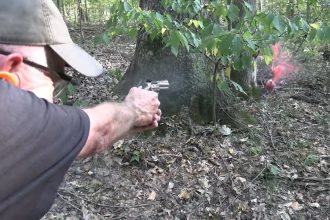A “Black Swan Event” is an extremely rare outlier event that gathers a disproportionate amount of attention after the fact due to its rare and unique nature. I recently saw a post on a social media platform where an anonymous firearms influencer was drawing attention to a well-known outlier event. The influencer admonished his followers that they should focus their training on being prepared for such extreme outlier events by spending lots of time shooting at long distances with a handgun. Given the reality that the average armed citizen has limited time and a limited budget with which to practice, I’m not sure that’s the best approach. While such outlier events are compelling, they should not overshadow the importance of using the majority of your training time and budget for more probable scenarios.
Risk Assessment
Risk assessment is an area that is rarely discussed in the self-defense training world, but it is an essential step in a holistic approach to self-protection. Situational awareness, verbal agility, shooting skill and other self-defense skills are all solutions. To choose the best solutions in the proper proportions, we must first understand the problem. That means doing a proper risk assessment.
The central concept of a risk assessment is weighing the probability and severity of potential risks. The goal is to develop a prioritized list of risks we need to mitigate. The process begins by brainstorming and listing any and every risk one can imagine. Then we go item by item and ask ourselves, “How severe would this be if it happened?” and “How likely is this to happen?” Formal risk assessment processes, (there is an entire industry based on this principle), apply numerical systems and an Internet search of “risk assessment matrix” will provide probably thousands of templates you can use to assign a ranked value to the severity and to the probability of a particular risk.
For our purposes here we can just informally categorize severity as “extreme severity,” “moderate severity” or “low severity.” Then “extremely likely,” “likely” or “not likely.” Anything that is extremely severe and highly likely should be at the top of your list, and probably needs to be addressed first. Anything that isn’t very severe and is not likely can go at the bottom of the list or get dropped off all together. Everything else will go somewhere in the middle based on your rankings, but the key is to perform this mental exercise as dispassionately as possible and render your judgments based on actual evidence and facts.
In the digital age, one would presume that we are more informed than ever about the world as it really is. Unfortunately, in this era of the Internet and social media, it can be extremely difficult to contextualize the flood of information and maintain perspective. The self-defense training community is no different, and so for many people there is a huge difference between what they worry about compared to what the evidence indicates they should actually be worried about.
One of the areas where this is most evident is defensively minded armed citizens’ preoccupation with outlier events. Conversely, lets examine the other end of the probability spectrum when it comes to problems that can be solved by armed self-defense. Generally speaking, aggravated assault/attempted murder, armed robbery (to include carjacking), abduction and rape are the crimes that can justify lethal force on the part of the intended victim. They also all generally occur at close distances, ranging from conversational distance to contact distance. The Bureau of Justice Statistics National Crime Victimization Survey reported a violent victimization rate of 23.5 per 1,000 people aged 12 and older in the US. So, in a given year the average citizen in the US has about a 23.5 out of 1,000 chance of being targeted for “routine” violent crime such as aggravated assault/attempted murder, robbery, abduction, or sexual assault.
Train for Probability
We understand that routine violent street crime is far more common than outlier events and both have the potential to make us dead. What can we infer about the problems we most need to be able to solve given this information? Primarily that the highly severe and more probable scenarios where we will need a gun to defend ourselves or our loved ones will likely take place at close proximity to our attacker. Let’s apply some good old-fashioned common sense:
For someone to get close enough to you to try to beat you with a tire iron, stab you, rob you at gunpoint, carjack you or try to abduct you, they’re generally going to have to get close to you. At the furthest, that will be conversational distance, and as close as hugging distance. This is true of the overwhelming majority of violent crime, and while the possibility of needing to shoot at a violent bad guy at 40 or more yards exists, and it does happen, the probability of it is quite low. Training for such an outlier probably shouldn’t make up a substantial portion of your training until you’re very consistent and skilled at solving the problems you are more likely to encounter.
For the vast majority of people, we need to prioritize the basics that we will need to survive and prevail in the type of defensive gun use scenario we’re significantly more likely to encounter. Those priorities include: A rock-solid reliable draw stroke from the holster; the ability to get the first good hit on target very, very rapidly; the ability to get additional accurate hits rapidly by managing recoil; the ability to use cover and the ability to shoot one-handed and from a retention position if you’re in gun-grabbing range. What distances should you be working at? Most people should be spending their time working on accuracy and speed from 3 to 10 yards until they can be accurate and fast on a consistent basis, cold and on demand. Then start working your way back to 15, 25, 50 yards and beyond. While it’s true that if you can shoot accurately at 50 or 100 yards you can easily do so at 3 to 10 yards, at long distance most people unconsciously ignore the time aspect that is so crucial in a defensive gun use at typical conversational distances. To get fast you’ve got to learn to go fast, and that means starting out being accurate and working on getting fast at 3 to 5 yards, then 7 to 10 yards, 10 to 15 yards and so on.
For the average defensive-minded shooter who has taken a class or two and makes it to the range a few times a year, if you want to spend a small portion of your precious practice time shooting at 25 to 50 yards or farther, that’s totally fine. Just be careful listening to somebody out there telling you that you need to abandon practicing at conversational distances so you can prepare for a Black Swan Event. It is a good thing to build skill at longer ranges with a pistol, and I enjoy shooting at 100 yards and beyond, but for most shooters it isn’t worth spending a significant amount of practice time working on skills you’re extremely unlikely to need at the expense of skills are that far more commonly called for. Weigh the severity and the probability, and prepare accordingly.
Read the full article here








